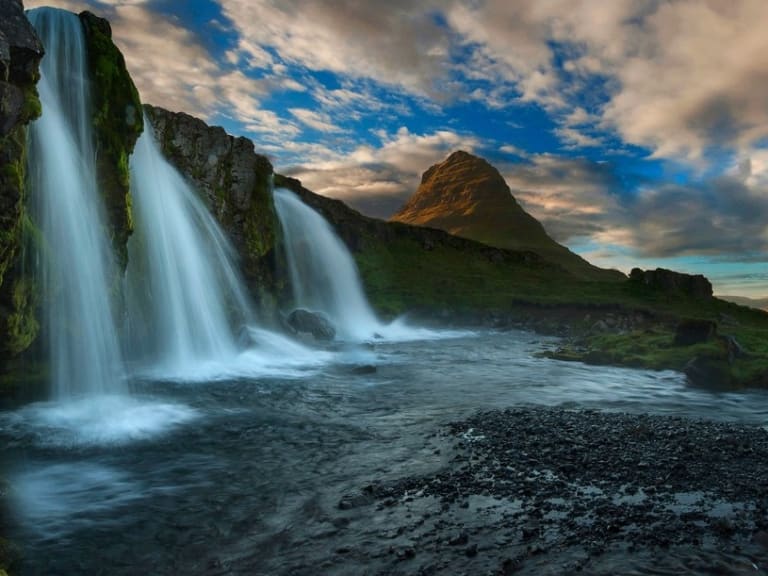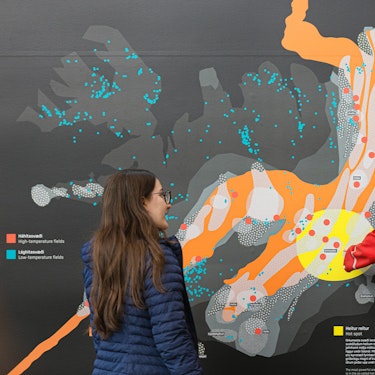More about: 10 Best Waterfall Tours in Iceland
Iceland is home to more than 10,000 waterfalls throughout the country. Some are unnamed, some are unknown, but will still make you stop and appreciate their beauty as you pass by. Others, however, are world-famous and there are several guided tours available to take you around them.
You can't possibly see all of Iceland's waterfalls, but there are a few that you should include in your travel itinerary, among the other things to see and do in Reykjavik. Here' s how to get there, where they're located and everything you need to know about Iceland's best waterfalls.
1. Gullfoss: Iceland's famous golden waterfall

This is one of **Iceland'**s busiest, most visited and most popular natural monuments. This is due to its beauty and its proximity to Reykjavik, as it is approximately 120 kilometres from the capital.
The most impressive thing about this waterfall is, without a doubt, its particular shape, which gives the impression that the earth swallowed the water. The waters that flow through Gullfoss belong to the so-called Hvítá, which means White River, and is the third longest river on the island.
It has three waterfalls: one of 11, one of 21 and one of 32 metres high. And it pours an average of 100 cubic metres of water per second.
How to get to Gullfoss
Its visit is included in the guided tours of the Golden Circle tourist route departing from Reykjavík. These tours are the best way to reach them and learn about their history in the company of an expert guide.
You can also get there by car from the capital in just 1.5 hours. The route is well signposted and you will reach the car park from the C35 road.
2. Brúarfoss: a turquoise waterfall in Iceland

It is considered one of the most beautiful and photographed waterfalls in Iceland and I highly recommend you visit it. What makes this waterfall unique is the turquoise colour of its waters, characteristic of its origin from nearby glaciers.
This waterfall will not surprise you with its grandeur, the power of its waters or the noise of the rushing water, but its charm goes beyond that. It is the set of small beauties such as its intense blue jets of water in harmony with the foam resulting from the current.
Trust me, when you see this waterfall, everything will make sense, you will be fascinated!
How to get to Brúarfoss
This waterfall is one of the closest to Reykjavík, so you can reach it from the capital by car or by booking a guided tour to the Golden Circle that includes it in its itinerary.
You'll find tours starting at around 55 euros. If you decide to go by car, you'll have parking next to road 37 and you'll have to walk about 3.5 kilometres to get there.
3. Seljalandsfoss: one of Iceland's most touristy waterfalls

This is one of the most impressive and touristy waterfalls in Iceland. It is located on the Ring Road on the south side of the island and is one of the most popular waterfalls.
It is a beautiful natural landscape with a height of 60 metres, from where the waters of the Seljalands River, with its source in the Eyjafjalljökull glacier, fall. Bear in mind that a visit to Iceland's glaciers, such as this one, is worth the effort.
I recommend that you schedule your visit at sunset, as it is known to provide an incredible spectacle when the sun goes down behind its waters.
How to get to Seljalandsfoss
This waterfall is located just off the Ring Road, a little less than 130 kilometres from Reykjavík. If you plan to drive, be aware that there is a car park right in front of the falls.
But I recommend a better option, which is a guided tour of the South Coast from Reykjavík that includes this dazzling waterfall in its itinerary.
4. Skógafoss: one of Iceland's most famous waterfalls

This is one of the largest waterfalls in Iceland, about 25 metres wide and 60 metres high, and its waters come from the melting of the Eyjafjalljökull glacier.
It is one of the most famous and visited waterfalls, not only for its natural beauty, but also for being featured in the renowned Game of Thrones series, like so many other Icelandic landscapes. For this reason, its visit is included in the tours inspired by this series.
Another of the reasons that make it the perfect waterfall are the single and double rainbows that it presents to visitors on sunny days, formed by the amount of foam produced by the falling water.
It is also a good place to go to see Iceland' s characteristic boreal haloes, which usually appear between September and April.
How to get to Skógafoss
You will reach it from the Ring Road and there is ample parking for you to leave your car.
There are also guided tours starting at around 80 euros that leave from Reykjavík and allow you to see the waterfalls and other scenery along Iceland's south coast.
5. Kvernufoss: Iceland's secret waterfall

This hidden, or rather, secret waterfall is a jewel you can't miss. It is located a few metres away from the Skógafoss waterfall, and you can reach it on foot. It is not one of the most popular waterfalls, so it is ideal to get away from the tourists and enjoy it almost in solitude.
Its waters come from the Kverná river which, like so many others, has its source in the Eyjafjallajokull glacier and has an impressive 30-metre drop.
Like the Seljalandsfoss waterfall, you will be able to experience the experience of walking behind it, achieving the best and most varied views and landscapes.
How to get there
Being so close to Skógafoss, you can get there by parking your car at the Skogar Museum and walking along the river for about 15 minutes.
6. Öxarárfoss: a waterfall inside Thingvellir National Park

This is a small waterfall located in Thingvellir National Park. Its base is surrounded by rocks and its waters flow along the course of the Öxara River, which flows through a lava field.
Although it is not one of the largest and most imposing, measuring just over 20 metres high, it is a unique natural beauty and its composition makes it worthy of being among the best in Iceland.
How to get to Öxarárfoss
The waterfall is located in Thingvellir National Park, about 50 kilometres from Reykjavík, making it easily accessible by car.
You can also reach it by taking an excursion to ThingvellirNational Park.
7. Glymur: one of Iceland's highest waterfalls

This is one of Iceland's highest waterfalls, with a grandiose drop of just under 200 metres and is easily accessible, being just over an hour from Reykjavík.
To visit this waterfall you'll need to bear in mind that you'll have to walk about 3.5 kilometres up and 3.5 kilometres down, which can take around 4 hours.
But it won't be a boring or monotonous hike: you'll find amazing views and scenery all along the way and it's well worth it.
How to get to Glymur
If you plan to drive, the route is fairly easy along the Ring Road and you can leave your car in the car park at Glymur to start the hike. Alternatively, you can take an excursion from Reykjavík that includes the waterfall on its itinerary.
8. Kirkjufellsfoss: one of Iceland's most popular waterfalls

One of Iceland's most popular waterfalls, it is located on the Snaefellsnes peninsula. Although it is often crowded with tourists and photographers, it is well worth a visit.
It is also the ideal place to enjoy boreal haloes and unique sunsets with Kirkjufell Mountain in the background.
It's funny, but this waterfall is neither the highest, nor does it have the greatest flow, but there is something about it that will grab you and you won't be able to stop looking at it. You will only be able to understand it when you are there. And that is exactly what makes it so popular and so popular with tourists.
How to get to Kirkjufellsfoss
By car, take road 54 towards Grundarfjörður and you'll find the car park in the village itself. If you are thinking of going on a hike, I recommend one of the many excursions around the Snaefellsnes peninsula.
9. Grundarfoss: a waterfall with the best scenery in Iceland

This waterfall is also located on the Snaefellsnes peninsula and you should visit it because it has a very particular charm. It is not one of the most popular or famous waterfalls, so you won't find so many tourists walking around and you will be able to appreciate it almost in solitude and it is well worth it!
The scenery with the snow-capped mountains in the background is one of the most beautiful you will see.
How to get to Grundarfoss
You will see it directly from the road on the left hand side, before reaching Grundarfjörður. Also, as it is on the Snaefellsnes peninsula, it may be included in an excursion, I recommend you check the itinerary.
10. Hraunfossar: the lava waterfall

Meet Hraunfossar, one of the lesser known waterfalls but, in my opinion, also one of the most beautiful in Iceland. It is also known as the Lava Waterfall, and its deep blue colour makes it unique and special.
I particularly recommend that you visit it in autumn, which is one of the best times of the year to visit Reykjavík, and the ideal time for the landscape around this waterfall to be tinged with the most diverse colours of vegetation, making it even more beautiful.
Next to this waterfall you will find another one, known as Barnafoss or the Children's Waterfall, which is known for a tragic legend that tells that two children died drowned in it several centuries ago. I recommend that you take advantage of your visit to Hraunfossar to see it.
How to get there
You have approximately 120 kilometres from Reykjavík to get to Hraunfossar along the Ring Road.
Waterfalls are undoubtedly one of Iceland's characteristic landscapes, but they are not the only ones, as this country offers a wide variety of natural beauties, all of which are worth a visit.
That's why I recommend that you take advantage of the guided excursions to these waterfalls, or your trip by car, to discover other magical places in Iceland, such as its glaciers, or to visit its impressive volcanoes.













